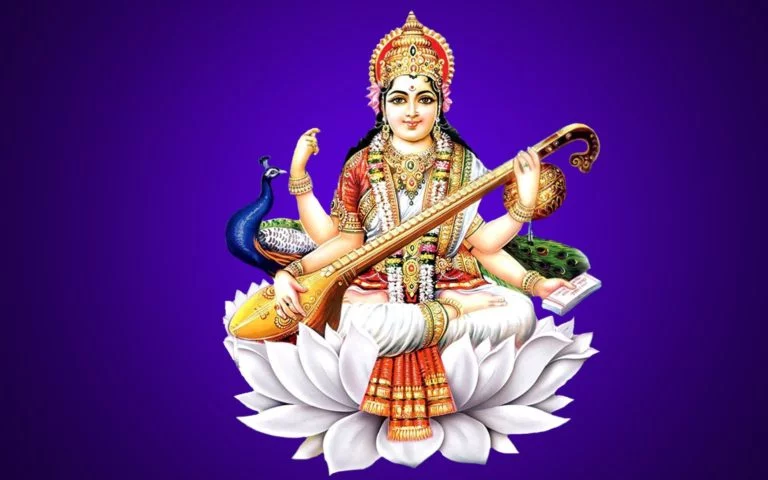
Saraswati is a revered goddess in Hinduism, known as the goddess of knowledge, wisdom, music, art, and learning. She is a part of the Hindu trinity of goddesses, alongside Lakshmi (goddess of wealth) and Parvati (goddess of power).
Here are key aspects related to Saraswati:
- Iconography: Saraswati is often depicted as a graceful and serene goddess seated on a white lotus, symbolizing purity and knowledge. She is adorned with white garments, representing clarity, and holds various symbolic items such as a veena (a musical instrument), a book (scriptures or knowledge), and a lotus.
- Veena: The veena, a stringed musical instrument, represents the arts and creativity. It symbolizes the harmony of mind and intellect.
- Swan: Saraswati is associated with a swan, which symbolizes discrimination between the good and the bad, as swans are believed to have the ability to separate milk from water.
- Scriptures: Saraswati is considered the source of the Vedas, the ancient Hindu scriptures. She is often depicted with a book, emphasizing her role as the bestower of knowledge.
- Vasant Panchami: The festival of Vasant Panchami is dedicated to Saraswati and is celebrated in the spring season. Devotees seek her blessings for academic success and artistic endeavors during this festival.
- Goddess of Learning: Saraswati is worshiped by students, scholars, and artists seeking knowledge and creativity. Her blessings are sought for success in education and the pursuit of higher learning.
- Saraswati Mantra: Devotees often chant Saraswati Mantras to invoke her blessings for wisdom and knowledge. The most famous mantra associated with her is the Saraswati Vandana.
- Cultural Significance: Saraswati plays a significant role in Indian classical music, dance, and arts. Many artists and performers invoke her before starting their creative endeavors.
- Brahma’s Consort: Saraswati is considered the consort of Lord Brahma, the creator in the Hindu trinity. The union of Saraswati and Brahma represents the synergy between knowledge and creation.
- River Saraswati: In ancient Hindu texts, Saraswati is also associated with the mythical river Saraswati, which is mentioned in the Rigveda.
Saraswati is revered not only in Hinduism but also in Jainism and Buddhism. She represents the embodiment of knowledge, creativity, and the arts, and her worship is a way to seek enlightenment and skill in various fields of learning.
Sarasvatl is the Sakti, the power and the consort of Brahma the creator. Hence she is the procreatrix, the mother, of the entire creation.
Literally SarasvatI means ‘the flowing one’. In the !J..gveda she represents a river and the deity presiding over it. Hence, she is connected with fertility and purification. Here are some of the names used to describe her: Sarada (giver of essence), VagIsvarI (mistress of speech), BrahmI (wife of Brahma), Mahavidya (knowledge supreme) and so on. It is obvious that the concept of SarasvatI, developed by the later mythological literature is already here. The ‘flow¬ing one’ can represent speech also if taken in an allegorical sense. Hence SarasvatI represents power and intelligence from which organized creation proceeds.
She is considered as the personification of all knowl¬edge-arts, sciences, crafts, and skills. Knowledge is the antithesis of the darkness of ignorance. Hence she is depicted as pure white in colour. Since she is the represen¬tation of all sciences, arts, crafts and skills she has to be extraordinarily beautiful and graceful. Clad in a spot¬less white apparel and seated on a lotus seat, she holds in her four hands a VIQa (lute), Ak~amala (rosary) and Pus taka (book). Though these are most common, there are several variations. Some of the other objects shown are: Pasa (noose), Ailkusa (goad), Padma (lotus), Trisula (trident), Sailkha (conch), Cakra (discus) and so on. Occasionally she is shown with five faces or with eight hands. Even three eyes or blue neck are not uncommon. In this case she is the MahasarasvatI aspect of Durga or ParvatL
Though no separate carrier vehicle is mentioned, Harhsa or swan, the vehicle of Brahma, her spouse, is usually associated with her also. In popular mythological literature and pictures, a peacock is also shown as her carrier vehicle.
Coming to the symbology: Being the consort of Brahma the creator, she represents his power and intelli¬gence, without which organized creation is impossible. To show that this intelligent power is stupendous and abso¬lutely pure, she is pictured as white and dazzling.
As usual, the four arms show her unimpeded power in all directions or her all-pervasiveness.
Being the goddess of learning, it is but proper that SarasvatI is shown holding a book in her left hand. The book represents all areas of secular sciences. Mere intellec¬tual learning, without a heart tempered by higher feelings, sentiments and emotions, is as dry as saw-dust. So she holds a VIQa (lute) on which she actually plays, to show the need for the cultivation of fine-arts. Then there is the Ak~amala (rosary) held in the right hand. This symbolises all spiritual sciences or Yoga including Tapas ( austerities), meditation and Japa (repetition of the divine name). By holding the book in the left hand and the rosary in the right hand she is obviously teaching us that spiritual sciences are more important than secular sciences.
The peacock with its beautiful plumage stands for this world in all its glory. Since the attractions of the world lead the spiritual aspirant astray, the peacock can actually sym¬bolise A vidya (ignorance or nescience). On the other hand the swan, which is supposed to possess the peculiar power of separating milk from water, stands for Viveka (wisdom, discrimination) and hence for Vidya (knowledge). Though it is true that Vidya or Paravidya (spiritual illumination)

